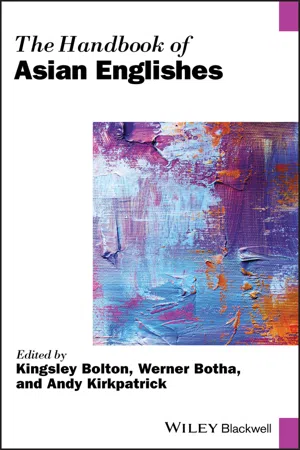
The Handbook of Asian Englishes
- English
- ePUB (mobile friendly)
- Available on iOS & Android
The Handbook of Asian Englishes
About This Book
The first volume of its kind, focusing on the sociolinguistic and socio-political issues surrounding Asian Englishes
The Handbook of Asian Englishes provides wide-ranging coverage of the historical and cultural context, contemporary dynamics, and linguistic features of English in use throughout the Asian region. This first-of-its-kind volume offers a wide-ranging exploration of the English language throughout nations in South Asia, Southeast Asia, and East Asia. Contributions by a team of internationally-recognized linguists and scholars of Asian Englishes and Asian languages survey existing works and review new and emerging areas of research in the field.
Edited by internationally renowned scholars in the field and structured in four parts, this Handbook explores the status and functions of English in the educational institutions, legal systems, media, popular cultures, and religions of diverse Asian societies. In addition to examining nation-specific topics, this comprehensive volume presents articles exploring pan-Asian issues such as English in Asian schools and universities, English and language policies in the Asian region, and the statistics of English across Asia. Up-to-date research addresses the impact of English as an Asian lingua franca, globalization and Asian Englishes, the dynamics of multilingualism, and more.
- Examines linguistic history, contemporary linguistic issues, and English in the Outer and Expanding Circles of Asia
- Focuses on the rapidly-growing complexities of English throughout Asia
- Includes reviews of the new frontiers of research in Asian Englishes, including the impact of globalization and popular culture
- Presents an innovative survey of Asian Englishes in one comprehensive volume
Serving as an important contribution to fields such as contact linguistics, World Englishes, sociolinguistics, and Asian language studies, The Handbook of Asian Englishes is an invaluable reference resource for undergraduate and graduate students, researchers, and instructors across these areas. Winner of the 2021 PROSE Humanities Category for Language & Linguistics
Frequently asked questions
Information
1
Asian Englishes Today
Introduction
First, a paradigm shift in research, teaching, and application of sociolinguistic realities to the functions of English. Second, a shift from frameworks and theories which are essentially appropriate only to monolingual countries. It is indeed essential to recognise that world Englishes represent certain linguistic, cultural and pragmatic realities and pluralism, and that pluralism is now an integral part of world Englishes and literatures written in Englishes. The pluralism of English must be reflected in the approaches, both theoretical and applied, we adopt for understanding this unprecedented linguistic phenomenon.(Kachru, 1992, p. 11)
Braj Kachru and Asian Englishes
The architects of each tradition, each strand, have moulded, reshaped, acculturated, redesigned, and – by doing so – enriched what was a Western medium. The result is a liberated English which contains vitality, innovation, linguistic mix, and cultural identity. And, it is not the creativity of the monolingual and the monocultural – this creativity has rejuvenated the medium from ‘exhaustion’ and has ‘liberated’ it in many ways.(Kachru, 1998, p. 106)
Table of contents
- Cover
- Table of Contents
- Title Page
- Copyright Page
- Notes on Contributors
- 1 Asian Englishes Today
- Part I: The History and Development of Asian Englishes
- Part II: English in Outer Circle Asian Societies
- Part III: English in Expanding Circle Asian Societies
- Part IV: New Frontiers of Research
- Index
- End User License Agreement